CVE80016 Swinburne University: Porosity & Adhesive Fatigue Life
VerifiedAdded on 2023/06/07
|54
|13433
|76
Report
AI Summary
This report investigates the impact of porosity on the fatigue life of structural adhesives, focusing on their application in civil engineering for repairing and strengthening structures. It covers the advantages and disadvantages of adhesive bonding compared to mechanical fasteners, explores different adhesive classifications and properties, and discusses the causes and effects of porosity. The methodology section details the analysis of porosity using software like Avizo 3D and ImageJ, referencing existing research and experimental results. The report contributes to understanding how porosity affects the durability and performance of structural adhesives under fatigue loading, essential for ensuring the longevity and reliability of retrofitted structures. Desklib provides access to this and other solved assignments.
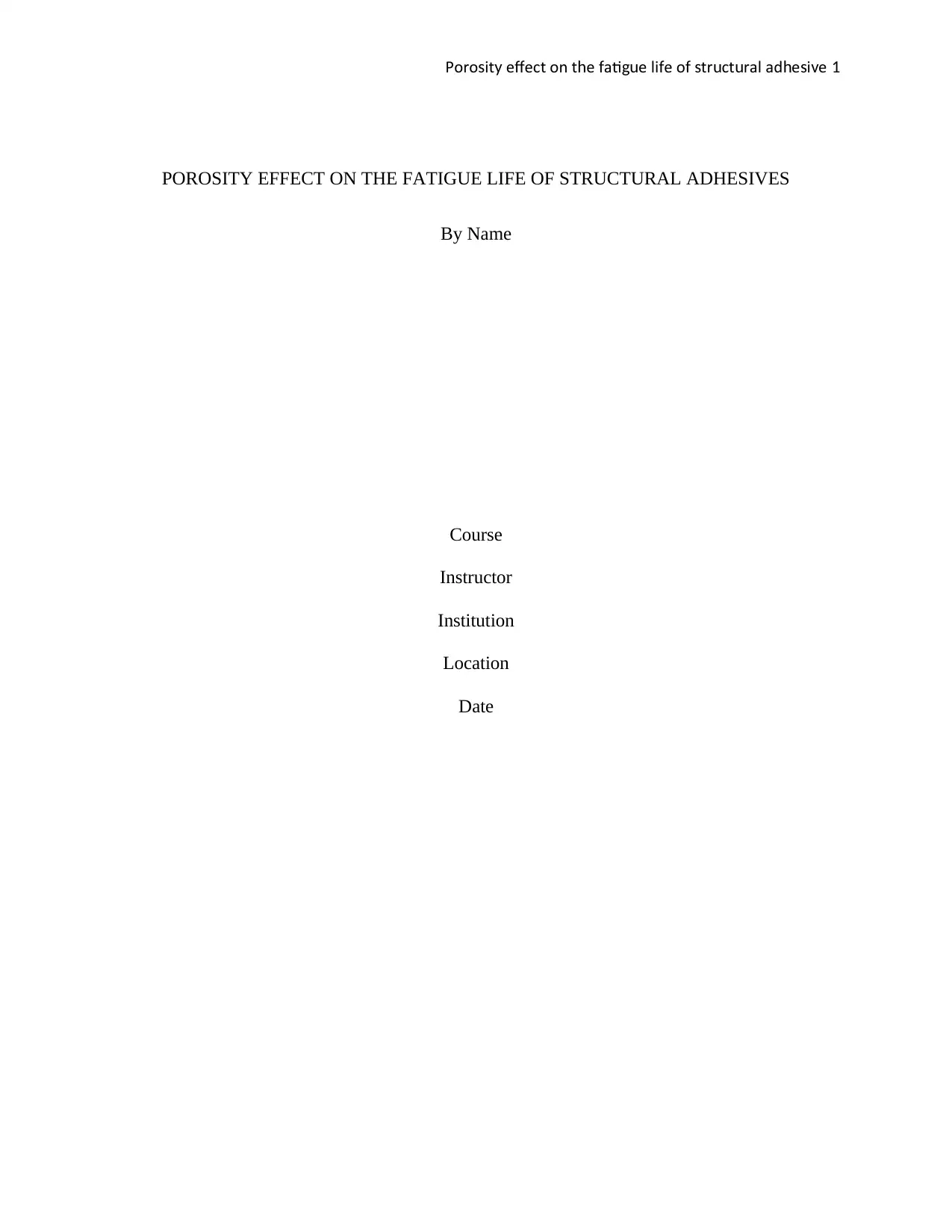
Poro it e ect on t e ati e li e o tr ct ral ad e i es y ff h f gu f f s u u h s v 1
POROSITY EFFECT ON THE FATIGUE LIFE OF STRUCTURAL ADHESIVES
By Name
Course
Instructor
Institution
Location
Date
POROSITY EFFECT ON THE FATIGUE LIFE OF STRUCTURAL ADHESIVES
By Name
Course
Instructor
Institution
Location
Date
Paraphrase This Document
Need a fresh take? Get an instant paraphrase of this document with our AI Paraphraser
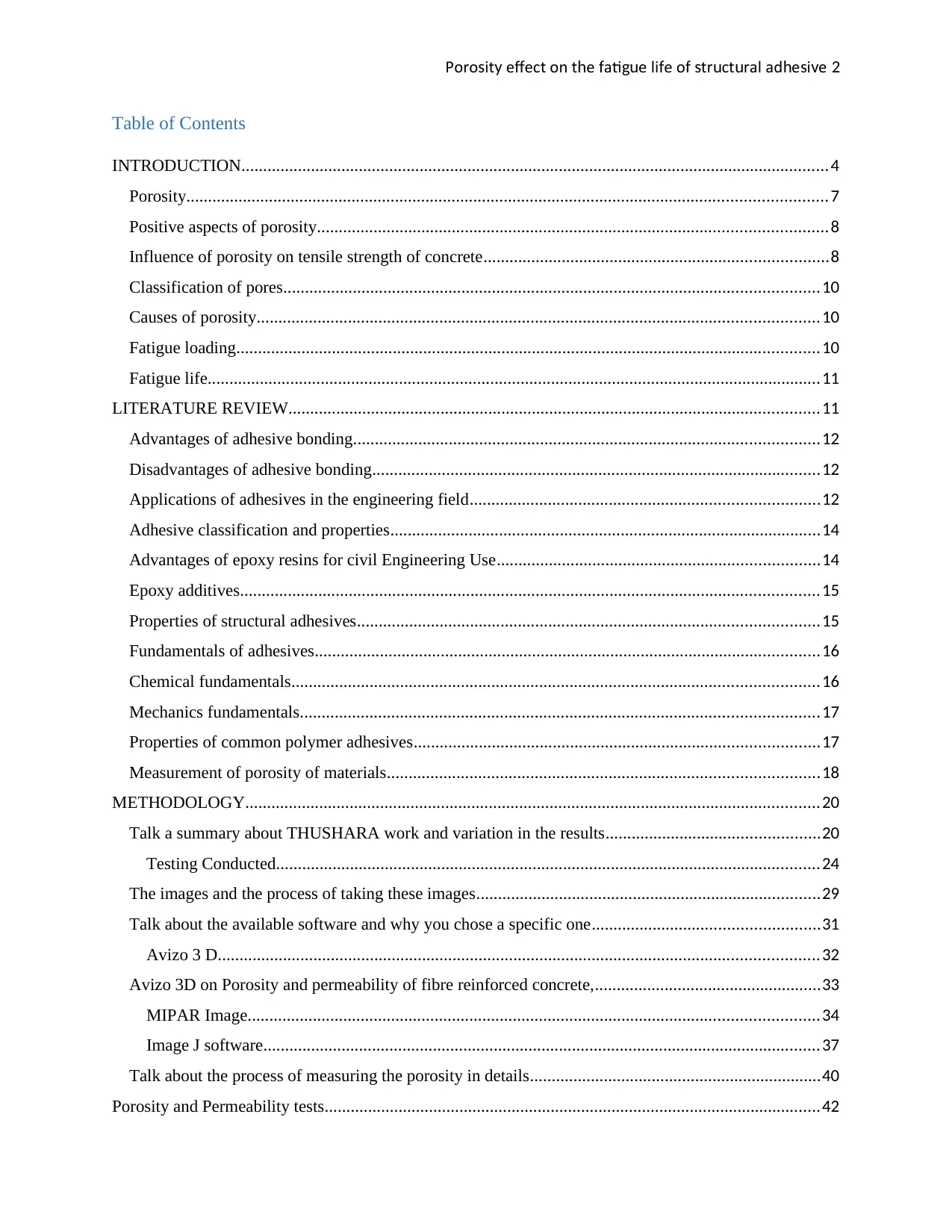
Poro it e ect on t e ati e li e o tr ct ral ad e i es y ff h f gu f f s u u h s v 2
Table of Contents
INTRODUCTION.......................................................................................................................................4
Porosity................................................................................................................................................... 7
Positive aspects of porosity.....................................................................................................................8
Influence of porosity on tensile strength of concrete...............................................................................8
Classification of pores...........................................................................................................................10
Causes of porosity.................................................................................................................................10
Fatigue loading......................................................................................................................................10
Fatigue life.............................................................................................................................................11
LITERATURE REVIEW..........................................................................................................................11
Advantages of adhesive bonding...........................................................................................................12
Disadvantages of adhesive bonding.......................................................................................................12
Applications of adhesives in the engineering field................................................................................12
Adhesive classification and properties...................................................................................................14
Advantages of epoxy resins for civil Engineering Use..........................................................................14
Epoxy additives.....................................................................................................................................15
Properties of structural adhesives..........................................................................................................15
Fundamentals of adhesives....................................................................................................................16
Chemical fundamentals.........................................................................................................................16
Mechanics fundamentals.......................................................................................................................17
Properties of common polymer adhesives.............................................................................................17
Measurement of porosity of materials...................................................................................................18
METHODOLOGY....................................................................................................................................20
Talk a summary about THUSHARA work and variation in the results.................................................20
Testing Conducted.............................................................................................................................24
The images and the process of taking these images...............................................................................29
Talk about the available software and why you chose a specific one....................................................31
Avizo 3 D..........................................................................................................................................32
Avizo 3D on Porosity and permeability of fibre reinforced concrete,....................................................33
MIPAR Image...................................................................................................................................34
Image J software................................................................................................................................37
Talk about the process of measuring the porosity in details...................................................................40
Porosity and Permeability tests..................................................................................................................42
Table of Contents
INTRODUCTION.......................................................................................................................................4
Porosity................................................................................................................................................... 7
Positive aspects of porosity.....................................................................................................................8
Influence of porosity on tensile strength of concrete...............................................................................8
Classification of pores...........................................................................................................................10
Causes of porosity.................................................................................................................................10
Fatigue loading......................................................................................................................................10
Fatigue life.............................................................................................................................................11
LITERATURE REVIEW..........................................................................................................................11
Advantages of adhesive bonding...........................................................................................................12
Disadvantages of adhesive bonding.......................................................................................................12
Applications of adhesives in the engineering field................................................................................12
Adhesive classification and properties...................................................................................................14
Advantages of epoxy resins for civil Engineering Use..........................................................................14
Epoxy additives.....................................................................................................................................15
Properties of structural adhesives..........................................................................................................15
Fundamentals of adhesives....................................................................................................................16
Chemical fundamentals.........................................................................................................................16
Mechanics fundamentals.......................................................................................................................17
Properties of common polymer adhesives.............................................................................................17
Measurement of porosity of materials...................................................................................................18
METHODOLOGY....................................................................................................................................20
Talk a summary about THUSHARA work and variation in the results.................................................20
Testing Conducted.............................................................................................................................24
The images and the process of taking these images...............................................................................29
Talk about the available software and why you chose a specific one....................................................31
Avizo 3 D..........................................................................................................................................32
Avizo 3D on Porosity and permeability of fibre reinforced concrete,....................................................33
MIPAR Image...................................................................................................................................34
Image J software................................................................................................................................37
Talk about the process of measuring the porosity in details...................................................................40
Porosity and Permeability tests..................................................................................................................42
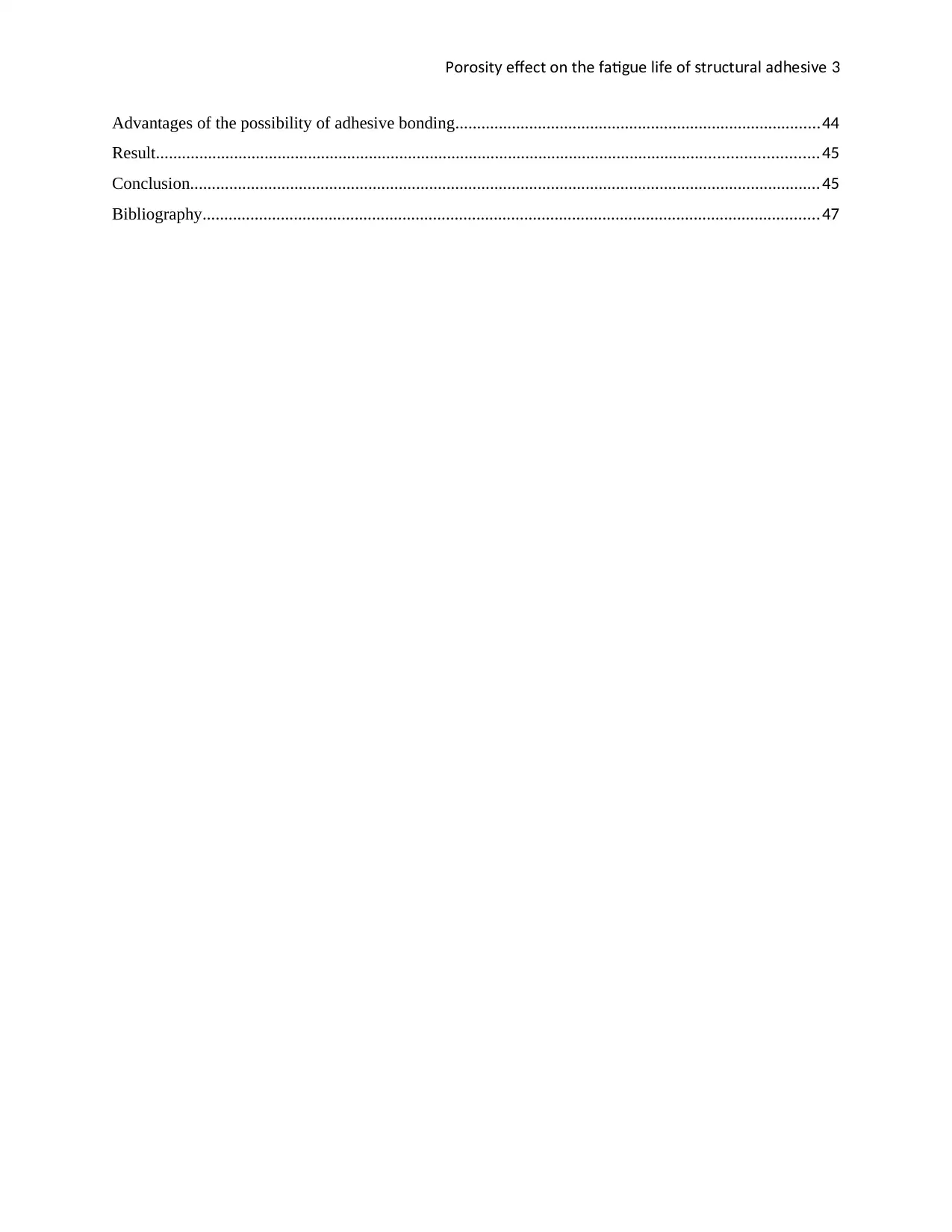
Poro it e ect on t e ati e li e o tr ct ral ad e i es y ff h f gu f f s u u h s v 3
Advantages of the possibility of adhesive bonding....................................................................................44
Result........................................................................................................................................................ 45
Conclusion.................................................................................................................................................45
Bibliography..............................................................................................................................................47
Advantages of the possibility of adhesive bonding....................................................................................44
Result........................................................................................................................................................ 45
Conclusion.................................................................................................................................................45
Bibliography..............................................................................................................................................47
⊘ This is a preview!⊘
Do you want full access?
Subscribe today to unlock all pages.

Trusted by 1+ million students worldwide
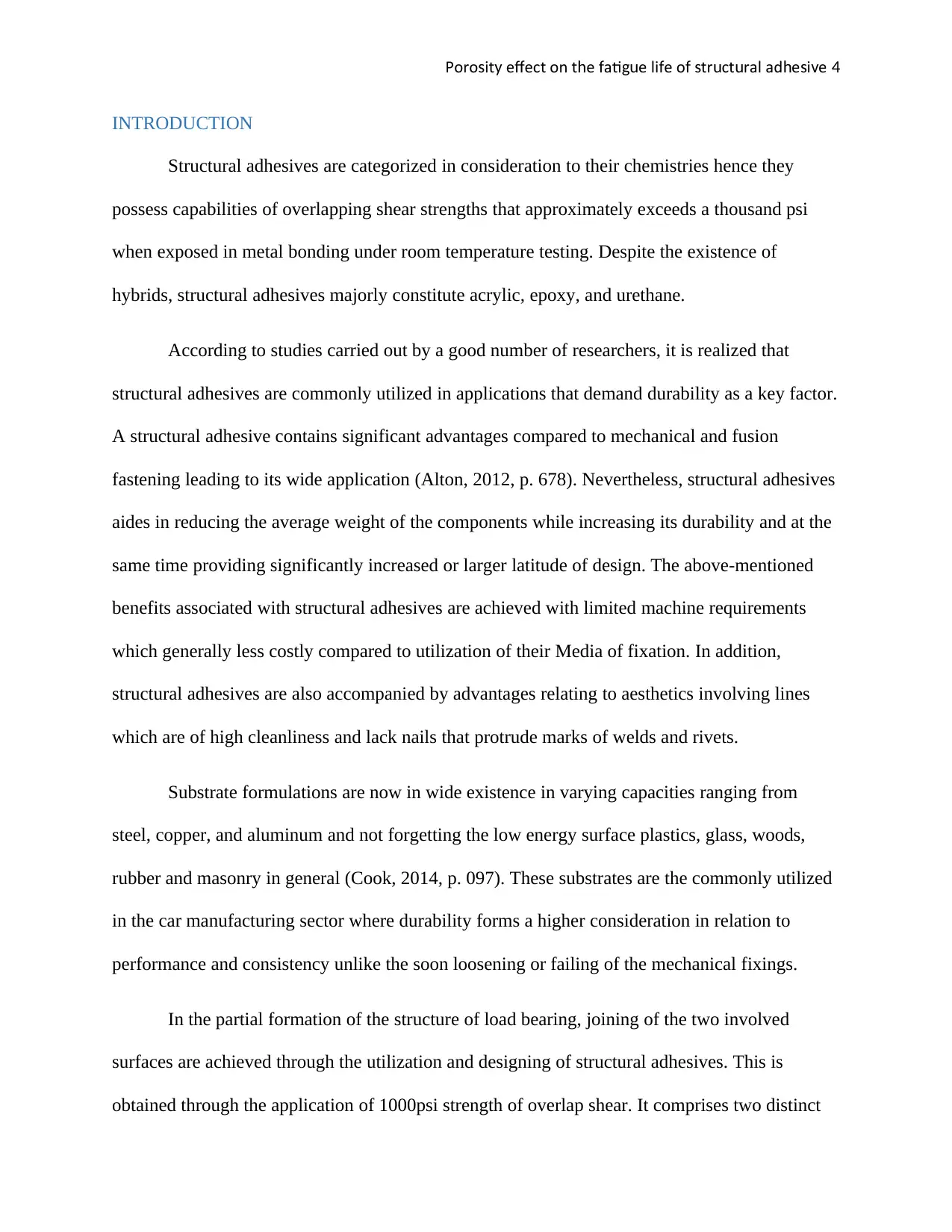
Poro it e ect on t e ati e li e o tr ct ral ad e i es y ff h f gu f f s u u h s v 4
INTRODUCTION
Structural adhesives are categorized in consideration to their chemistries hence they
possess capabilities of overlapping shear strengths that approximately exceeds a thousand psi
when exposed in metal bonding under room temperature testing. Despite the existence of
hybrids, structural adhesives majorly constitute acrylic, epoxy, and urethane.
According to studies carried out by a good number of researchers, it is realized that
structural adhesives are commonly utilized in applications that demand durability as a key factor.
A structural adhesive contains significant advantages compared to mechanical and fusion
fastening leading to its wide application (Alton, 2012, p. 678). Nevertheless, structural adhesives
aides in reducing the average weight of the components while increasing its durability and at the
same time providing significantly increased or larger latitude of design. The above-mentioned
benefits associated with structural adhesives are achieved with limited machine requirements
which generally less costly compared to utilization of their Media of fixation. In addition,
structural adhesives are also accompanied by advantages relating to aesthetics involving lines
which are of high cleanliness and lack nails that protrude marks of welds and rivets.
Substrate formulations are now in wide existence in varying capacities ranging from
steel, copper, and aluminum and not forgetting the low energy surface plastics, glass, woods,
rubber and masonry in general (Cook, 2014, p. 097). These substrates are the commonly utilized
in the car manufacturing sector where durability forms a higher consideration in relation to
performance and consistency unlike the soon loosening or failing of the mechanical fixings.
In the partial formation of the structure of load bearing, joining of the two involved
surfaces are achieved through the utilization and designing of structural adhesives. This is
obtained through the application of 1000psi strength of overlap shear. It comprises two distinct
INTRODUCTION
Structural adhesives are categorized in consideration to their chemistries hence they
possess capabilities of overlapping shear strengths that approximately exceeds a thousand psi
when exposed in metal bonding under room temperature testing. Despite the existence of
hybrids, structural adhesives majorly constitute acrylic, epoxy, and urethane.
According to studies carried out by a good number of researchers, it is realized that
structural adhesives are commonly utilized in applications that demand durability as a key factor.
A structural adhesive contains significant advantages compared to mechanical and fusion
fastening leading to its wide application (Alton, 2012, p. 678). Nevertheless, structural adhesives
aides in reducing the average weight of the components while increasing its durability and at the
same time providing significantly increased or larger latitude of design. The above-mentioned
benefits associated with structural adhesives are achieved with limited machine requirements
which generally less costly compared to utilization of their Media of fixation. In addition,
structural adhesives are also accompanied by advantages relating to aesthetics involving lines
which are of high cleanliness and lack nails that protrude marks of welds and rivets.
Substrate formulations are now in wide existence in varying capacities ranging from
steel, copper, and aluminum and not forgetting the low energy surface plastics, glass, woods,
rubber and masonry in general (Cook, 2014, p. 097). These substrates are the commonly utilized
in the car manufacturing sector where durability forms a higher consideration in relation to
performance and consistency unlike the soon loosening or failing of the mechanical fixings.
In the partial formation of the structure of load bearing, joining of the two involved
surfaces are achieved through the utilization and designing of structural adhesives. This is
obtained through the application of 1000psi strength of overlap shear. It comprises two distinct
Paraphrase This Document
Need a fresh take? Get an instant paraphrase of this document with our AI Paraphraser
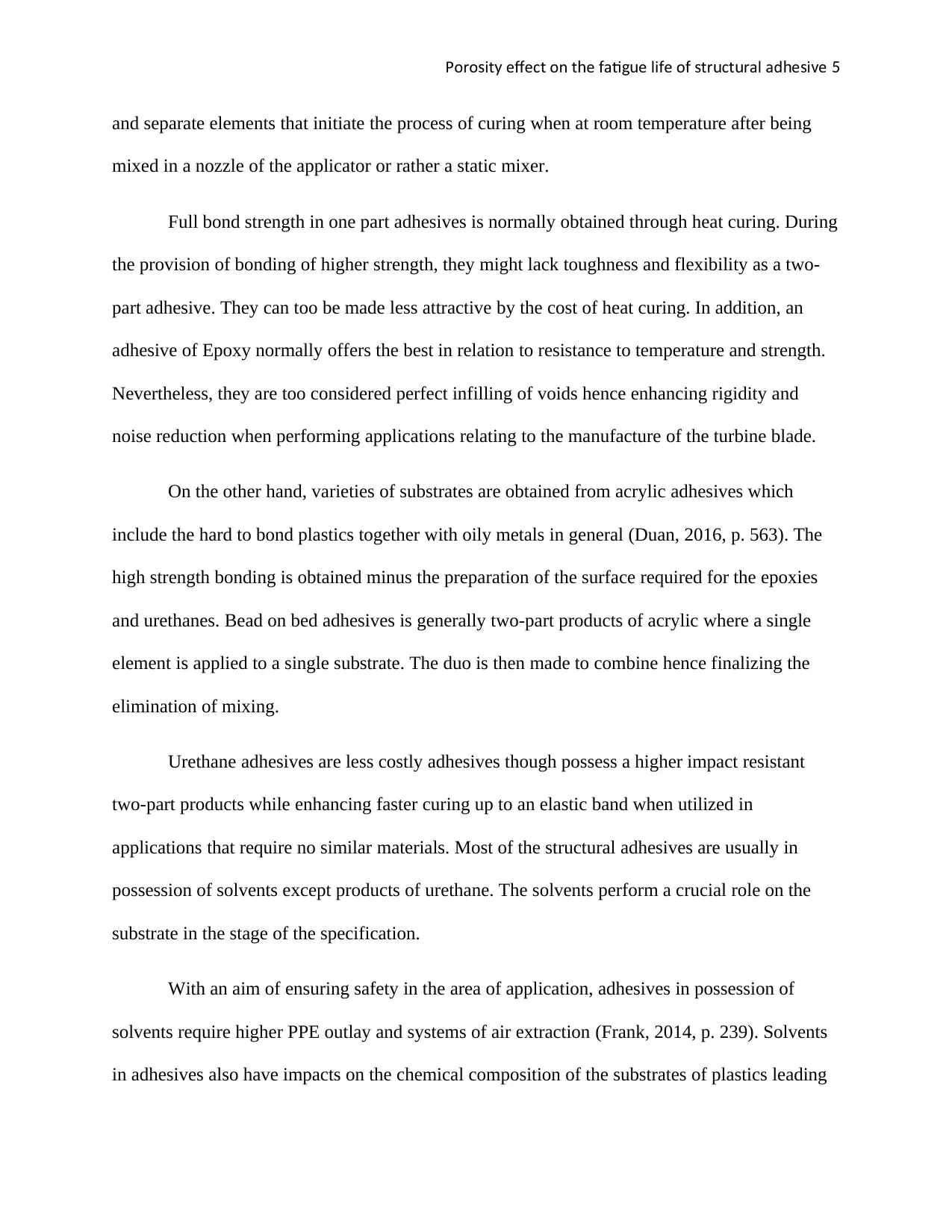
Poro it e ect on t e ati e li e o tr ct ral ad e i es y ff h f gu f f s u u h s v 5
and separate elements that initiate the process of curing when at room temperature after being
mixed in a nozzle of the applicator or rather a static mixer.
Full bond strength in one part adhesives is normally obtained through heat curing. During
the provision of bonding of higher strength, they might lack toughness and flexibility as a two-
part adhesive. They can too be made less attractive by the cost of heat curing. In addition, an
adhesive of Epoxy normally offers the best in relation to resistance to temperature and strength.
Nevertheless, they are too considered perfect infilling of voids hence enhancing rigidity and
noise reduction when performing applications relating to the manufacture of the turbine blade.
On the other hand, varieties of substrates are obtained from acrylic adhesives which
include the hard to bond plastics together with oily metals in general (Duan, 2016, p. 563). The
high strength bonding is obtained minus the preparation of the surface required for the epoxies
and urethanes. Bead on bed adhesives is generally two-part products of acrylic where a single
element is applied to a single substrate. The duo is then made to combine hence finalizing the
elimination of mixing.
Urethane adhesives are less costly adhesives though possess a higher impact resistant
two-part products while enhancing faster curing up to an elastic band when utilized in
applications that require no similar materials. Most of the structural adhesives are usually in
possession of solvents except products of urethane. The solvents perform a crucial role on the
substrate in the stage of the specification.
With an aim of ensuring safety in the area of application, adhesives in possession of
solvents require higher PPE outlay and systems of air extraction (Frank, 2014, p. 239). Solvents
in adhesives also have impacts on the chemical composition of the substrates of plastics leading
and separate elements that initiate the process of curing when at room temperature after being
mixed in a nozzle of the applicator or rather a static mixer.
Full bond strength in one part adhesives is normally obtained through heat curing. During
the provision of bonding of higher strength, they might lack toughness and flexibility as a two-
part adhesive. They can too be made less attractive by the cost of heat curing. In addition, an
adhesive of Epoxy normally offers the best in relation to resistance to temperature and strength.
Nevertheless, they are too considered perfect infilling of voids hence enhancing rigidity and
noise reduction when performing applications relating to the manufacture of the turbine blade.
On the other hand, varieties of substrates are obtained from acrylic adhesives which
include the hard to bond plastics together with oily metals in general (Duan, 2016, p. 563). The
high strength bonding is obtained minus the preparation of the surface required for the epoxies
and urethanes. Bead on bed adhesives is generally two-part products of acrylic where a single
element is applied to a single substrate. The duo is then made to combine hence finalizing the
elimination of mixing.
Urethane adhesives are less costly adhesives though possess a higher impact resistant
two-part products while enhancing faster curing up to an elastic band when utilized in
applications that require no similar materials. Most of the structural adhesives are usually in
possession of solvents except products of urethane. The solvents perform a crucial role on the
substrate in the stage of the specification.
With an aim of ensuring safety in the area of application, adhesives in possession of
solvents require higher PPE outlay and systems of air extraction (Frank, 2014, p. 239). Solvents
in adhesives also have impacts on the chemical composition of the substrates of plastics leading
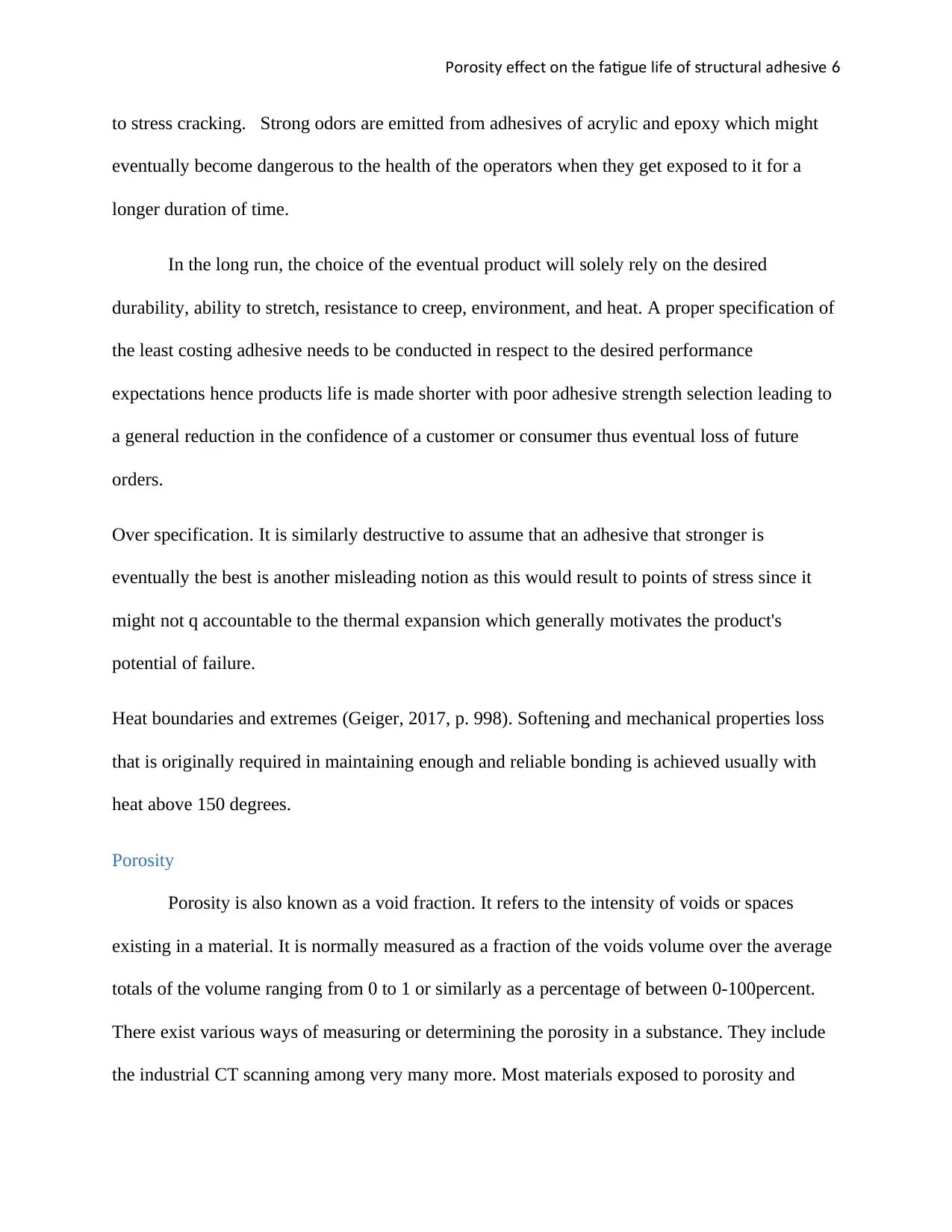
Poro it e ect on t e ati e li e o tr ct ral ad e i es y ff h f gu f f s u u h s v 6
to stress cracking. Strong odors are emitted from adhesives of acrylic and epoxy which might
eventually become dangerous to the health of the operators when they get exposed to it for a
longer duration of time.
In the long run, the choice of the eventual product will solely rely on the desired
durability, ability to stretch, resistance to creep, environment, and heat. A proper specification of
the least costing adhesive needs to be conducted in respect to the desired performance
expectations hence products life is made shorter with poor adhesive strength selection leading to
a general reduction in the confidence of a customer or consumer thus eventual loss of future
orders.
Over specification. It is similarly destructive to assume that an adhesive that stronger is
eventually the best is another misleading notion as this would result to points of stress since it
might not q accountable to the thermal expansion which generally motivates the product's
potential of failure.
Heat boundaries and extremes (Geiger, 2017, p. 998). Softening and mechanical properties loss
that is originally required in maintaining enough and reliable bonding is achieved usually with
heat above 150 degrees.
Porosity
Porosity is also known as a void fraction. It refers to the intensity of voids or spaces
existing in a material. It is normally measured as a fraction of the voids volume over the average
totals of the volume ranging from 0 to 1 or similarly as a percentage of between 0-100percent.
There exist various ways of measuring or determining the porosity in a substance. They include
the industrial CT scanning among very many more. Most materials exposed to porosity and
to stress cracking. Strong odors are emitted from adhesives of acrylic and epoxy which might
eventually become dangerous to the health of the operators when they get exposed to it for a
longer duration of time.
In the long run, the choice of the eventual product will solely rely on the desired
durability, ability to stretch, resistance to creep, environment, and heat. A proper specification of
the least costing adhesive needs to be conducted in respect to the desired performance
expectations hence products life is made shorter with poor adhesive strength selection leading to
a general reduction in the confidence of a customer or consumer thus eventual loss of future
orders.
Over specification. It is similarly destructive to assume that an adhesive that stronger is
eventually the best is another misleading notion as this would result to points of stress since it
might not q accountable to the thermal expansion which generally motivates the product's
potential of failure.
Heat boundaries and extremes (Geiger, 2017, p. 998). Softening and mechanical properties loss
that is originally required in maintaining enough and reliable bonding is achieved usually with
heat above 150 degrees.
Porosity
Porosity is also known as a void fraction. It refers to the intensity of voids or spaces
existing in a material. It is normally measured as a fraction of the voids volume over the average
totals of the volume ranging from 0 to 1 or similarly as a percentage of between 0-100percent.
There exist various ways of measuring or determining the porosity in a substance. They include
the industrial CT scanning among very many more. Most materials exposed to porosity and
⊘ This is a preview!⊘
Do you want full access?
Subscribe today to unlock all pages.

Trusted by 1+ million students worldwide
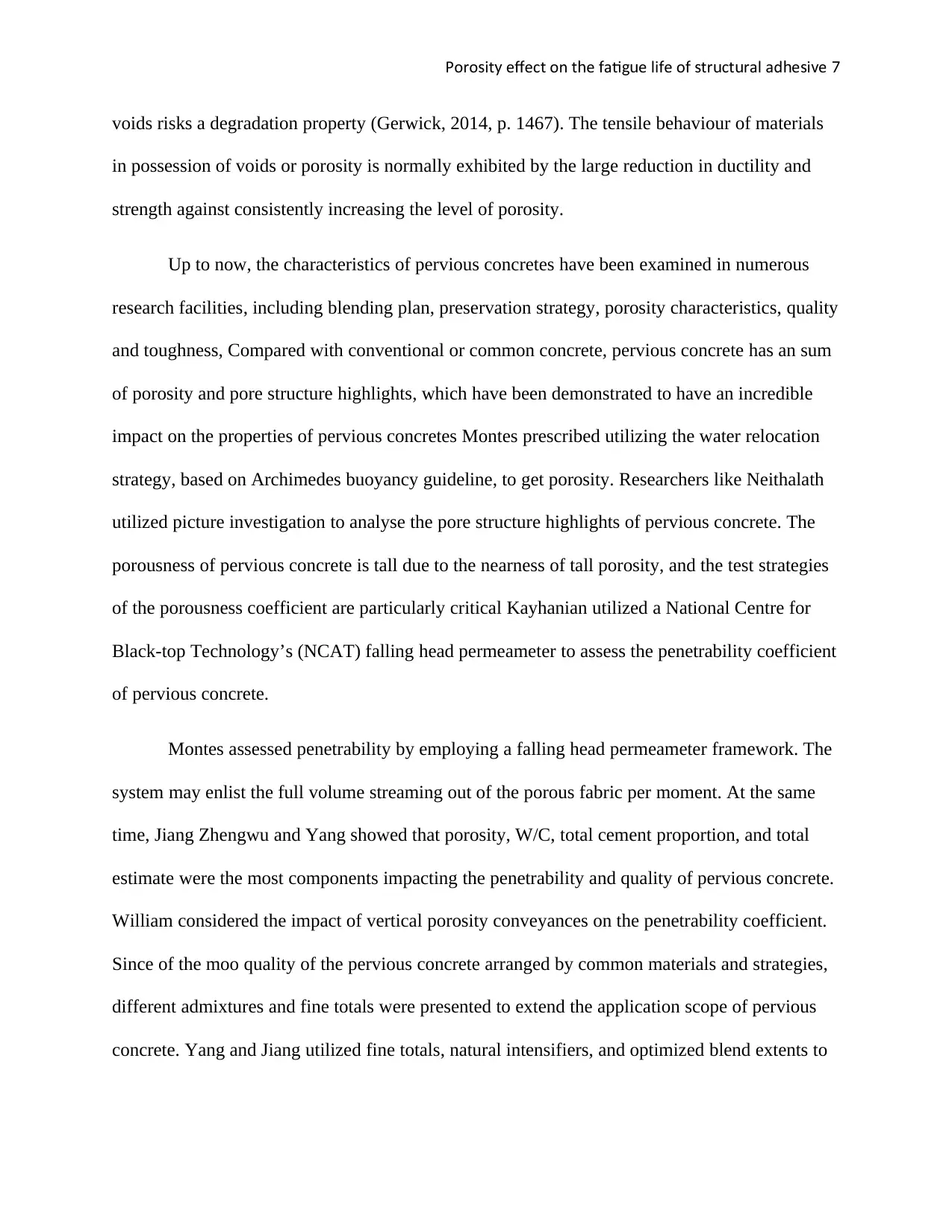
Poro it e ect on t e ati e li e o tr ct ral ad e i es y ff h f gu f f s u u h s v 7
voids risks a degradation property (Gerwick, 2014, p. 1467). The tensile behaviour of materials
in possession of voids or porosity is normally exhibited by the large reduction in ductility and
strength against consistently increasing the level of porosity.
Up to now, the characteristics of pervious concretes have been examined in numerous
research facilities, including blending plan, preservation strategy, porosity characteristics, quality
and toughness, Compared with conventional or common concrete, pervious concrete has an sum
of porosity and pore structure highlights, which have been demonstrated to have an incredible
impact on the properties of pervious concretes Montes prescribed utilizing the water relocation
strategy, based on Archimedes buoyancy guideline, to get porosity. Researchers like Neithalath
utilized picture investigation to analyse the pore structure highlights of pervious concrete. The
porousness of pervious concrete is tall due to the nearness of tall porosity, and the test strategies
of the porousness coefficient are particularly critical Kayhanian utilized a National Centre for
Black-top Technology’s (NCAT) falling head permeameter to assess the penetrability coefficient
of pervious concrete.
Montes assessed penetrability by employing a falling head permeameter framework. The
system may enlist the full volume streaming out of the porous fabric per moment. At the same
time, Jiang Zhengwu and Yang showed that porosity, W/C, total cement proportion, and total
estimate were the most components impacting the penetrability and quality of pervious concrete.
William considered the impact of vertical porosity conveyances on the penetrability coefficient.
Since of the moo quality of the pervious concrete arranged by common materials and strategies,
different admixtures and fine totals were presented to extend the application scope of pervious
concrete. Yang and Jiang utilized fine totals, natural intensifiers, and optimized blend extents to
voids risks a degradation property (Gerwick, 2014, p. 1467). The tensile behaviour of materials
in possession of voids or porosity is normally exhibited by the large reduction in ductility and
strength against consistently increasing the level of porosity.
Up to now, the characteristics of pervious concretes have been examined in numerous
research facilities, including blending plan, preservation strategy, porosity characteristics, quality
and toughness, Compared with conventional or common concrete, pervious concrete has an sum
of porosity and pore structure highlights, which have been demonstrated to have an incredible
impact on the properties of pervious concretes Montes prescribed utilizing the water relocation
strategy, based on Archimedes buoyancy guideline, to get porosity. Researchers like Neithalath
utilized picture investigation to analyse the pore structure highlights of pervious concrete. The
porousness of pervious concrete is tall due to the nearness of tall porosity, and the test strategies
of the porousness coefficient are particularly critical Kayhanian utilized a National Centre for
Black-top Technology’s (NCAT) falling head permeameter to assess the penetrability coefficient
of pervious concrete.
Montes assessed penetrability by employing a falling head permeameter framework. The
system may enlist the full volume streaming out of the porous fabric per moment. At the same
time, Jiang Zhengwu and Yang showed that porosity, W/C, total cement proportion, and total
estimate were the most components impacting the penetrability and quality of pervious concrete.
William considered the impact of vertical porosity conveyances on the penetrability coefficient.
Since of the moo quality of the pervious concrete arranged by common materials and strategies,
different admixtures and fine totals were presented to extend the application scope of pervious
concrete. Yang and Jiang utilized fine totals, natural intensifiers, and optimized blend extents to
Paraphrase This Document
Need a fresh take? Get an instant paraphrase of this document with our AI Paraphraser
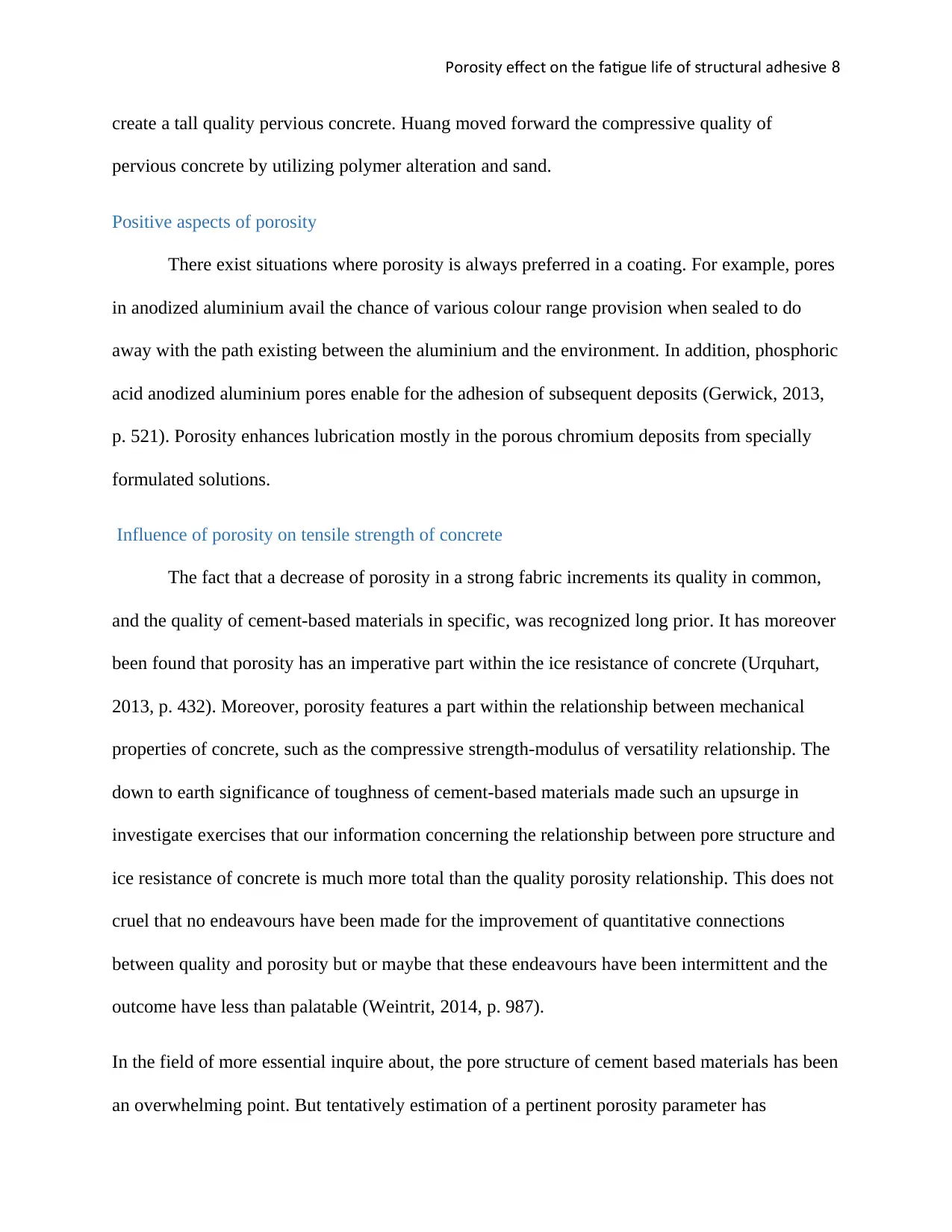
Poro it e ect on t e ati e li e o tr ct ral ad e i es y ff h f gu f f s u u h s v 8
create a tall quality pervious concrete. Huang moved forward the compressive quality of
pervious concrete by utilizing polymer alteration and sand.
Positive aspects of porosity
There exist situations where porosity is always preferred in a coating. For example, pores
in anodized aluminium avail the chance of various colour range provision when sealed to do
away with the path existing between the aluminium and the environment. In addition, phosphoric
acid anodized aluminium pores enable for the adhesion of subsequent deposits (Gerwick, 2013,
p. 521). Porosity enhances lubrication mostly in the porous chromium deposits from specially
formulated solutions.
Influence of porosity on tensile strength of concrete
The fact that a decrease of porosity in a strong fabric increments its quality in common,
and the quality of cement-based materials in specific, was recognized long prior. It has moreover
been found that porosity has an imperative part within the ice resistance of concrete (Urquhart,
2013, p. 432). Moreover, porosity features a part within the relationship between mechanical
properties of concrete, such as the compressive strength-modulus of versatility relationship. The
down to earth significance of toughness of cement-based materials made such an upsurge in
investigate exercises that our information concerning the relationship between pore structure and
ice resistance of concrete is much more total than the quality porosity relationship. This does not
cruel that no endeavours have been made for the improvement of quantitative connections
between quality and porosity but or maybe that these endeavours have been intermittent and the
outcome have less than palatable (Weintrit, 2014, p. 987).
In the field of more essential inquire about, the pore structure of cement based materials has been
an overwhelming point. But tentatively estimation of a pertinent porosity parameter has
create a tall quality pervious concrete. Huang moved forward the compressive quality of
pervious concrete by utilizing polymer alteration and sand.
Positive aspects of porosity
There exist situations where porosity is always preferred in a coating. For example, pores
in anodized aluminium avail the chance of various colour range provision when sealed to do
away with the path existing between the aluminium and the environment. In addition, phosphoric
acid anodized aluminium pores enable for the adhesion of subsequent deposits (Gerwick, 2013,
p. 521). Porosity enhances lubrication mostly in the porous chromium deposits from specially
formulated solutions.
Influence of porosity on tensile strength of concrete
The fact that a decrease of porosity in a strong fabric increments its quality in common,
and the quality of cement-based materials in specific, was recognized long prior. It has moreover
been found that porosity has an imperative part within the ice resistance of concrete (Urquhart,
2013, p. 432). Moreover, porosity features a part within the relationship between mechanical
properties of concrete, such as the compressive strength-modulus of versatility relationship. The
down to earth significance of toughness of cement-based materials made such an upsurge in
investigate exercises that our information concerning the relationship between pore structure and
ice resistance of concrete is much more total than the quality porosity relationship. This does not
cruel that no endeavours have been made for the improvement of quantitative connections
between quality and porosity but or maybe that these endeavours have been intermittent and the
outcome have less than palatable (Weintrit, 2014, p. 987).
In the field of more essential inquire about, the pore structure of cement based materials has been
an overwhelming point. But tentatively estimation of a pertinent porosity parameter has
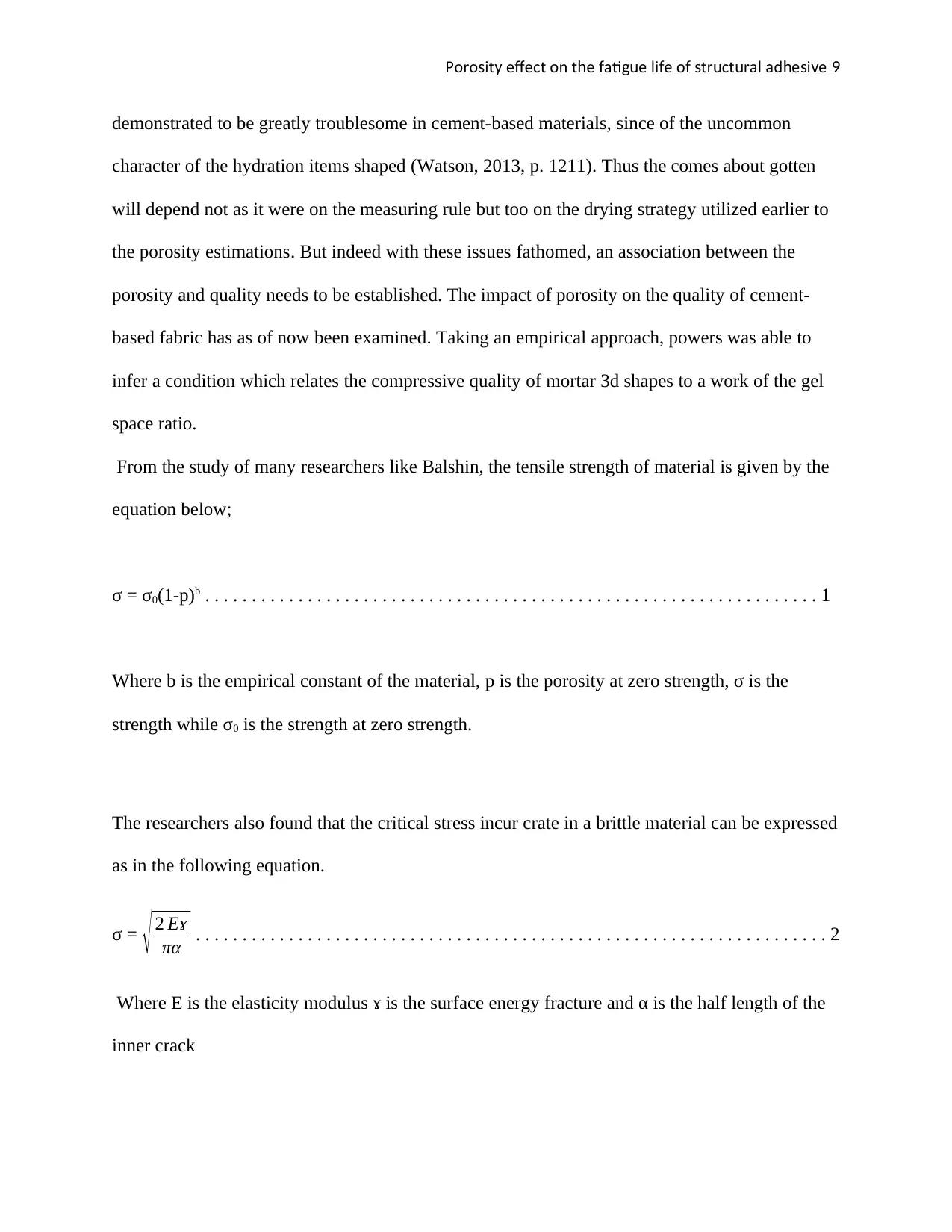
Poro it e ect on t e ati e li e o tr ct ral ad e i es y ff h f gu f f s u u h s v 9
demonstrated to be greatly troublesome in cement-based materials, since of the uncommon
character of the hydration items shaped (Watson, 2013, p. 1211). Thus the comes about gotten
will depend not as it were on the measuring rule but too on the drying strategy utilized earlier to
the porosity estimations. But indeed with these issues fathomed, an association between the
porosity and quality needs to be established. The impact of porosity on the quality of cement-
based fabric has as of now been examined. Taking an empirical approach, powers was able to
infer a condition which relates the compressive quality of mortar 3d shapes to a work of the gel
space ratio.
From the study of many researchers like Balshin, the tensile strength of material is given by the
equation below;
σ = σ0(1-p)b . . . . . . . . . . . . . . . . . . . . . . . . . . . . . . . . . . . . . . . . . . . . . . . . . . . . . . . . . . . . . . . . . . 1
Where b is the empirical constant of the material, p is the porosity at zero strength, σ is the
strength while σ0 is the strength at zero strength.
The researchers also found that the critical stress incur crate in a brittle material can be expressed
as in the following equation.
σ = √ 2 Eɤ
πα . . . . . . . . . . . . . . . . . . . . . . . . . . . . . . . . . . . . . . . . . . . . . . . . . . . . . . . . . . . . . . . . . . . . 2
Where E is the elasticity modulus ɤ is the surface energy fracture and α is the half length of the
inner crack
demonstrated to be greatly troublesome in cement-based materials, since of the uncommon
character of the hydration items shaped (Watson, 2013, p. 1211). Thus the comes about gotten
will depend not as it were on the measuring rule but too on the drying strategy utilized earlier to
the porosity estimations. But indeed with these issues fathomed, an association between the
porosity and quality needs to be established. The impact of porosity on the quality of cement-
based fabric has as of now been examined. Taking an empirical approach, powers was able to
infer a condition which relates the compressive quality of mortar 3d shapes to a work of the gel
space ratio.
From the study of many researchers like Balshin, the tensile strength of material is given by the
equation below;
σ = σ0(1-p)b . . . . . . . . . . . . . . . . . . . . . . . . . . . . . . . . . . . . . . . . . . . . . . . . . . . . . . . . . . . . . . . . . . 1
Where b is the empirical constant of the material, p is the porosity at zero strength, σ is the
strength while σ0 is the strength at zero strength.
The researchers also found that the critical stress incur crate in a brittle material can be expressed
as in the following equation.
σ = √ 2 Eɤ
πα . . . . . . . . . . . . . . . . . . . . . . . . . . . . . . . . . . . . . . . . . . . . . . . . . . . . . . . . . . . . . . . . . . . . 2
Where E is the elasticity modulus ɤ is the surface energy fracture and α is the half length of the
inner crack
⊘ This is a preview!⊘
Do you want full access?
Subscribe today to unlock all pages.

Trusted by 1+ million students worldwide
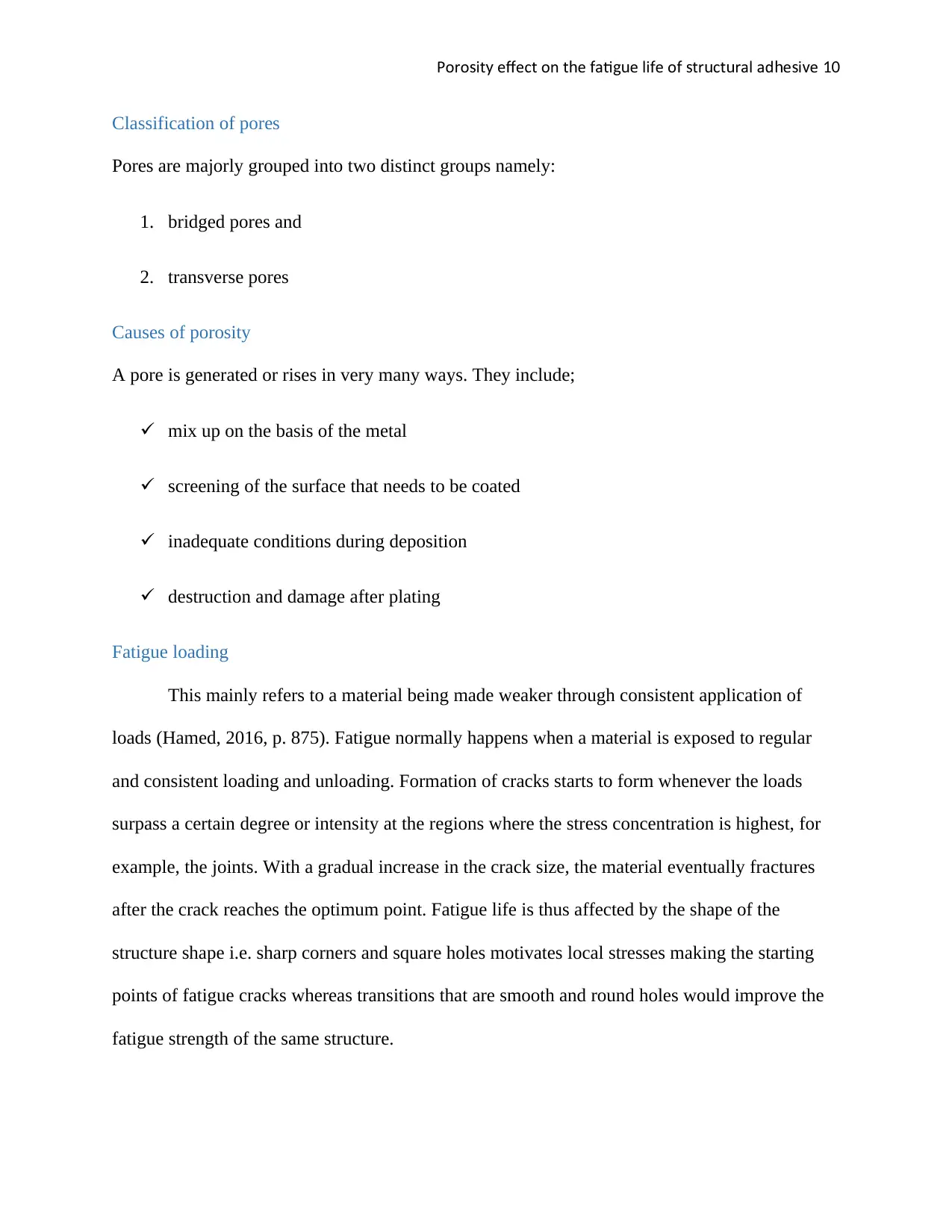
Poro it e ect on t e ati e li e o tr ct ral ad e i es y ff h f gu f f s u u h s v 10
Classification of pores
Pores are majorly grouped into two distinct groups namely:
1. bridged pores and
2. transverse pores
Causes of porosity
A pore is generated or rises in very many ways. They include;
mix up on the basis of the metal
screening of the surface that needs to be coated
inadequate conditions during deposition
destruction and damage after plating
Fatigue loading
This mainly refers to a material being made weaker through consistent application of
loads (Hamed, 2016, p. 875). Fatigue normally happens when a material is exposed to regular
and consistent loading and unloading. Formation of cracks starts to form whenever the loads
surpass a certain degree or intensity at the regions where the stress concentration is highest, for
example, the joints. With a gradual increase in the crack size, the material eventually fractures
after the crack reaches the optimum point. Fatigue life is thus affected by the shape of the
structure shape i.e. sharp corners and square holes motivates local stresses making the starting
points of fatigue cracks whereas transitions that are smooth and round holes would improve the
fatigue strength of the same structure.
Classification of pores
Pores are majorly grouped into two distinct groups namely:
1. bridged pores and
2. transverse pores
Causes of porosity
A pore is generated or rises in very many ways. They include;
mix up on the basis of the metal
screening of the surface that needs to be coated
inadequate conditions during deposition
destruction and damage after plating
Fatigue loading
This mainly refers to a material being made weaker through consistent application of
loads (Hamed, 2016, p. 875). Fatigue normally happens when a material is exposed to regular
and consistent loading and unloading. Formation of cracks starts to form whenever the loads
surpass a certain degree or intensity at the regions where the stress concentration is highest, for
example, the joints. With a gradual increase in the crack size, the material eventually fractures
after the crack reaches the optimum point. Fatigue life is thus affected by the shape of the
structure shape i.e. sharp corners and square holes motivates local stresses making the starting
points of fatigue cracks whereas transitions that are smooth and round holes would improve the
fatigue strength of the same structure.
Paraphrase This Document
Need a fresh take? Get an instant paraphrase of this document with our AI Paraphraser
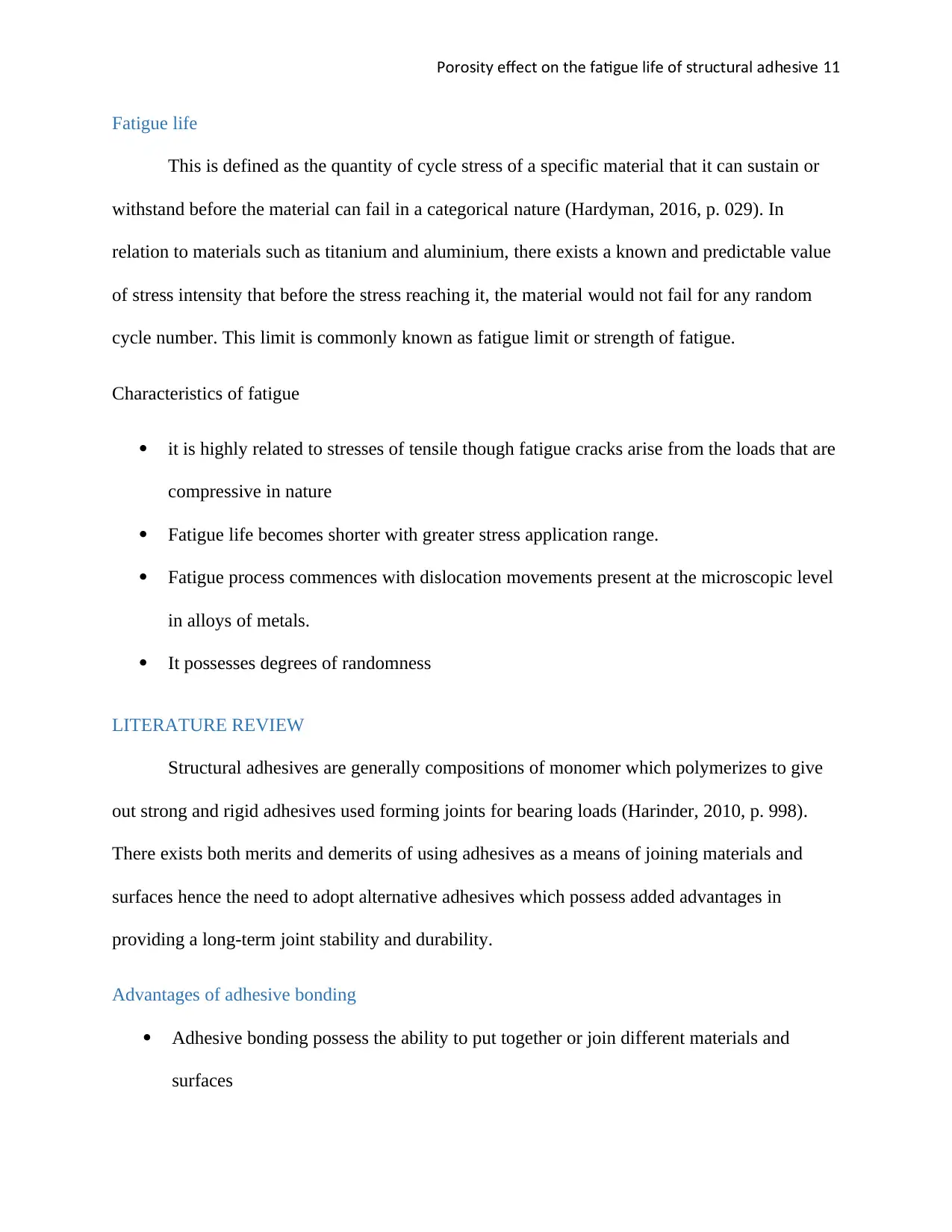
Poro it e ect on t e ati e li e o tr ct ral ad e i es y ff h f gu f f s u u h s v 11
Fatigue life
This is defined as the quantity of cycle stress of a specific material that it can sustain or
withstand before the material can fail in a categorical nature (Hardyman, 2016, p. 029). In
relation to materials such as titanium and aluminium, there exists a known and predictable value
of stress intensity that before the stress reaching it, the material would not fail for any random
cycle number. This limit is commonly known as fatigue limit or strength of fatigue.
Characteristics of fatigue
it is highly related to stresses of tensile though fatigue cracks arise from the loads that are
compressive in nature
Fatigue life becomes shorter with greater stress application range.
Fatigue process commences with dislocation movements present at the microscopic level
in alloys of metals.
It possesses degrees of randomness
LITERATURE REVIEW
Structural adhesives are generally compositions of monomer which polymerizes to give
out strong and rigid adhesives used forming joints for bearing loads (Harinder, 2010, p. 998).
There exists both merits and demerits of using adhesives as a means of joining materials and
surfaces hence the need to adopt alternative adhesives which possess added advantages in
providing a long-term joint stability and durability.
Advantages of adhesive bonding
Adhesive bonding possess the ability to put together or join different materials and
surfaces
Fatigue life
This is defined as the quantity of cycle stress of a specific material that it can sustain or
withstand before the material can fail in a categorical nature (Hardyman, 2016, p. 029). In
relation to materials such as titanium and aluminium, there exists a known and predictable value
of stress intensity that before the stress reaching it, the material would not fail for any random
cycle number. This limit is commonly known as fatigue limit or strength of fatigue.
Characteristics of fatigue
it is highly related to stresses of tensile though fatigue cracks arise from the loads that are
compressive in nature
Fatigue life becomes shorter with greater stress application range.
Fatigue process commences with dislocation movements present at the microscopic level
in alloys of metals.
It possesses degrees of randomness
LITERATURE REVIEW
Structural adhesives are generally compositions of monomer which polymerizes to give
out strong and rigid adhesives used forming joints for bearing loads (Harinder, 2010, p. 998).
There exists both merits and demerits of using adhesives as a means of joining materials and
surfaces hence the need to adopt alternative adhesives which possess added advantages in
providing a long-term joint stability and durability.
Advantages of adhesive bonding
Adhesive bonding possess the ability to put together or join different materials and
surfaces
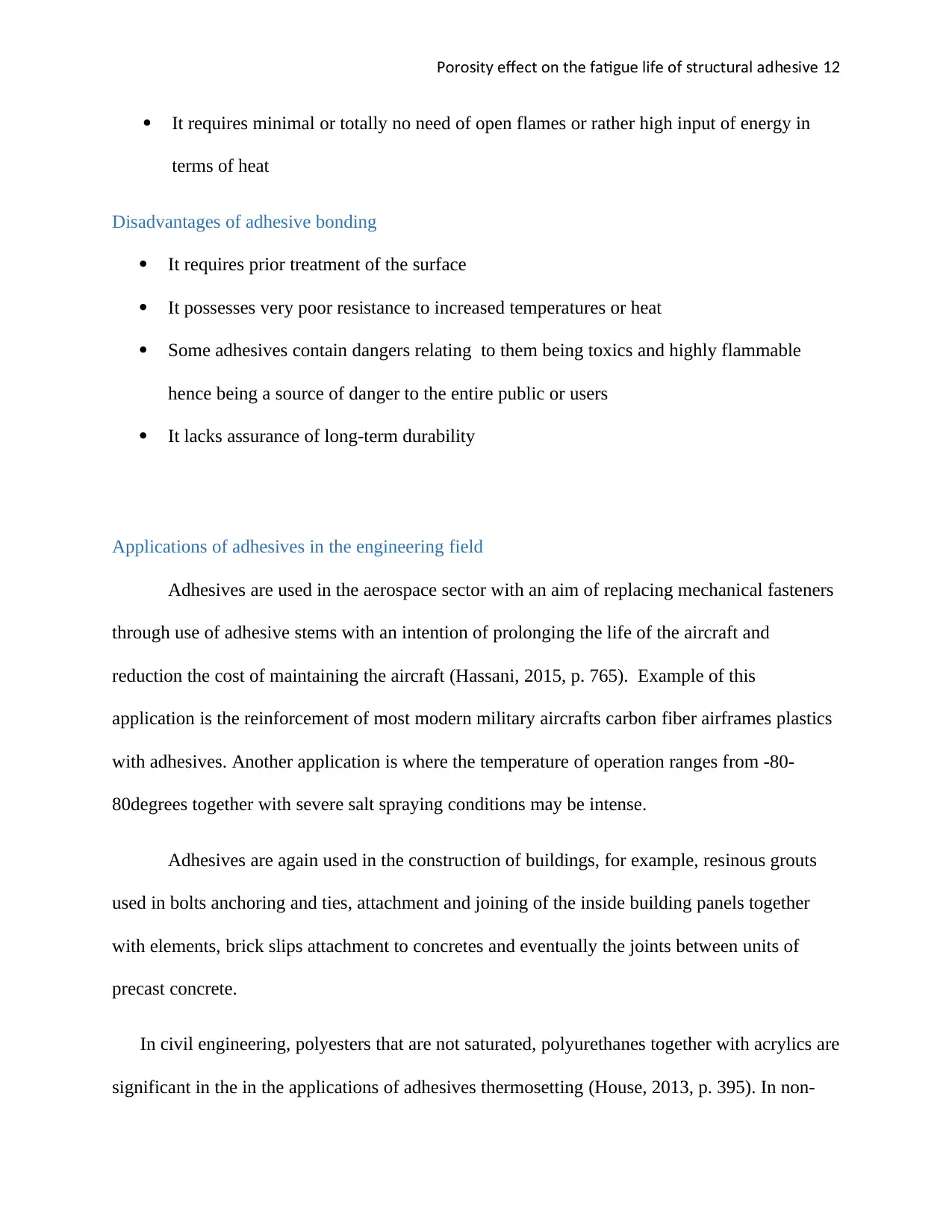
Poro it e ect on t e ati e li e o tr ct ral ad e i es y ff h f gu f f s u u h s v 12
It requires minimal or totally no need of open flames or rather high input of energy in
terms of heat
Disadvantages of adhesive bonding
It requires prior treatment of the surface
It possesses very poor resistance to increased temperatures or heat
Some adhesives contain dangers relating to them being toxics and highly flammable
hence being a source of danger to the entire public or users
It lacks assurance of long-term durability
Applications of adhesives in the engineering field
Adhesives are used in the aerospace sector with an aim of replacing mechanical fasteners
through use of adhesive stems with an intention of prolonging the life of the aircraft and
reduction the cost of maintaining the aircraft (Hassani, 2015, p. 765). Example of this
application is the reinforcement of most modern military aircrafts carbon fiber airframes plastics
with adhesives. Another application is where the temperature of operation ranges from -80-
80degrees together with severe salt spraying conditions may be intense.
Adhesives are again used in the construction of buildings, for example, resinous grouts
used in bolts anchoring and ties, attachment and joining of the inside building panels together
with elements, brick slips attachment to concretes and eventually the joints between units of
precast concrete.
In civil engineering, polyesters that are not saturated, polyurethanes together with acrylics are
significant in the in the applications of adhesives thermosetting (House, 2013, p. 395). In non-
It requires minimal or totally no need of open flames or rather high input of energy in
terms of heat
Disadvantages of adhesive bonding
It requires prior treatment of the surface
It possesses very poor resistance to increased temperatures or heat
Some adhesives contain dangers relating to them being toxics and highly flammable
hence being a source of danger to the entire public or users
It lacks assurance of long-term durability
Applications of adhesives in the engineering field
Adhesives are used in the aerospace sector with an aim of replacing mechanical fasteners
through use of adhesive stems with an intention of prolonging the life of the aircraft and
reduction the cost of maintaining the aircraft (Hassani, 2015, p. 765). Example of this
application is the reinforcement of most modern military aircrafts carbon fiber airframes plastics
with adhesives. Another application is where the temperature of operation ranges from -80-
80degrees together with severe salt spraying conditions may be intense.
Adhesives are again used in the construction of buildings, for example, resinous grouts
used in bolts anchoring and ties, attachment and joining of the inside building panels together
with elements, brick slips attachment to concretes and eventually the joints between units of
precast concrete.
In civil engineering, polyesters that are not saturated, polyurethanes together with acrylics are
significant in the in the applications of adhesives thermosetting (House, 2013, p. 395). In non-
⊘ This is a preview!⊘
Do you want full access?
Subscribe today to unlock all pages.

Trusted by 1+ million students worldwide
1 out of 54
Your All-in-One AI-Powered Toolkit for Academic Success.
+13062052269
info@desklib.com
Available 24*7 on WhatsApp / Email
![[object Object]](/_next/static/media/star-bottom.7253800d.svg)
Unlock your academic potential
Copyright © 2020–2025 A2Z Services. All Rights Reserved. Developed and managed by ZUCOL.
